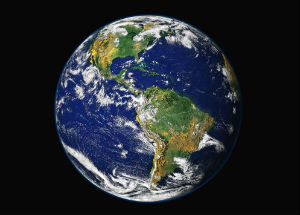Harnessing chaos could help climate modelling take leap forward
05 August 2020

Understanding the chaotic variability of the climate and its response to climate change could help scientists better forecast changes that still elude even the most sophisticated models.
A mathematical framework proposed in the journal Reviews of Modern Physics aims to incorporate coherently the interplay between the normal climate variability, due to countless processes constantly occurring on the Earth’s land, oceans, and atmosphere, and anthropogenic and natural influences – something that is still unsatisfactorily addressed in current climate predictions.
This could allow more accurate predictions of the most extreme impacts of human-caused greenhouse gas emissions and natural events, such as the tipping points associated with the melting of sea ice or irreversible temperature changes.
The study was led by Professor Valerio Lucarini at the University of Reading and colleague Professor Michael Ghil from the Ecole Normale Supérieure in Paris, France, and the University of California in the US, and has been supported via the EU Horizon 2020 climate science project TiPES (Tipping Points in the Earth System). TiPES is coordinated and led by The Niels Bohr Institute at the University of Copenhagen, Denmark.
“We propose ideas to perform much more effective climate simulations than the traditional approach of relying exclusively on bigger and bigger models" - Professor Valerio Lucarini, University of Reading
The Earth is changing at an unprecedented speed, yet there is still great uncertainty about the consequences. Increasingly detailed, physics-based models are improving steadily, but an in-depth understanding of the persisting uncertainties is still lacking.
The new framework proposes a pathway to overcoming the two main challenges in increasing this understanding: obtaining the necessary amount of detail in models, and accurately predicting how anthropogenic carbon dioxide disturbs the climate's intrinsic, natural variability.
“We propose ideas to perform much more effective climate simulations than the traditional approach of relying exclusively on bigger and bigger models,” said Professor Valerio Lucarini, from the Department of Mathematics and Statistics at the University of Reading, and CEN Meteorological Institute at the University of Hamburg, Germany.
“We show how to extract much more information at much higher predictive power from those models. We think it is a valuable, original and much more effective way than a lot of things that are being done.”
Model failures
The authors argue a new approach is urgently needed because current climate models generally fail in performing two important tasks.
First, they cannot reduce the uncertainty in determining the mean global temperature at the surface after a doubling of carbon dioxide in the atmosphere. This number is called equilibrium climate sensitivity and in 1979 it was computed to 1.5-4 degrees Celsius. Since then the uncertainty has grown. Today it is 1.5-6 degrees in spite of decades of improvement to numerical models and huge gains in computational power over the same period.
Second, climate models struggle to predict tipping points, which occur when a subsystem i.e. a sea current, an ice sheet, a landscape or an ecosystem suddenly and irrevocably shift from one state to another.
These kind of events are well documented in historical records and pose a major threat to modern societies. Still, they are not predicted with sufficient accuracy by the high-end climate models that the IPCC assessments rely upon.
These difficulties are grounded in the fact that mathematical methodology used in most high-resolution climate calculations does not reproduce well deterministically chaotic behaviour nor the associated uncertainties in the presence of time-dependent deterministic and stochastic forcings.
A chaotic world
Chaotic behaviour is intrinsic to the Earth system as very different physical, chemical, geological and biological processes like cloud formation, sedimentation, weathering, ocean currents, wind patterns, moisture, photosynthesis etc. range in timescales from microseconds to million of years. Apart from that, the system is forced mainly by solar radiation which varies naturally over time, but also by anthropogenic changes to the atmosphere. Thus, the Earth system is highly complex, deterministically chaotic, stochastically perturbed and never in equilibrium.
Professor Ghil said: “What we are doing is essentially extending deterministic chaos to a much more general mathematical framework, which provides the tools to determine the response of the climate system to all sorts of forcings, deterministic as well as stochastic.”
The fundamental ideas to the proposed approach are not entirely new, as the mathematical theory was developed decades ago. However, the merit of the paper is to make the theory accessible and usable for climate research and to provide usable tools for improving and testing climate models. Such interdisciplinary approaches involving the climate science community as well as experts in applied mathematics, theoretical physics and dynamical systems theory have been emerging too slowly until now.
The authors hope the review paper will accelerate this tendency as it describes the mathematical tools needed for such work.
Professor Lucarini said: “We present a self-consistent understanding of climate change and climate variability in a well-defined coherent framework. I think that is an important step in solving the problem, because first of all you have to pose it correctly. So the idea is, if we use the conceptual tools we discuss extensively in our paper, we might hope to help climate science and climate modelling make a leap forward.”
The new review closely follows another paper (link: https://iopscience.iop.org/article/10.1088/1361-6544/ab86cc) published in a recent issue of the journal Nonlinearity.
This paper looked at using complex mathematics to improve understanding of tipping points in the Earth system through the concept of Melancholia states, and better predict changes to systems that can radically alter their state. These include ecological, biological, social and other systems.
